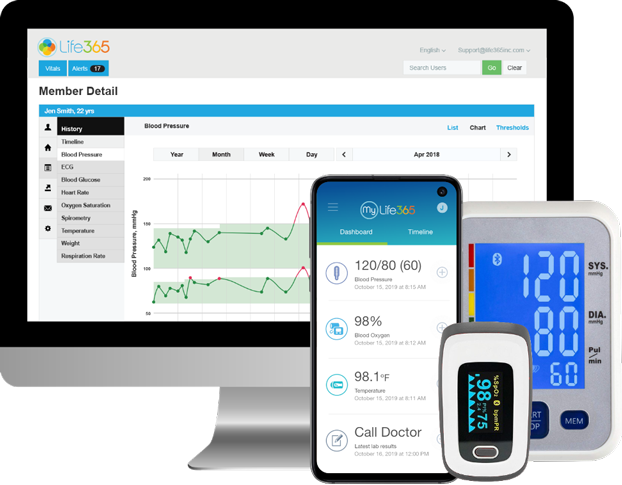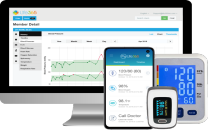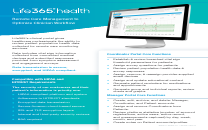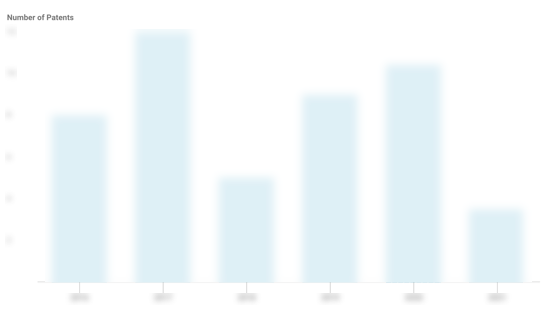
Life365
Founded Year
2015Stage
Unattributed | AliveTotal Raised
$3MValuation
$0000Last Raised
$3M | 4 yrs agoMosaic Score The Mosaic Score is an algorithm that measures the overall financial health and market potential of private companies.
+168 points in the past 30 days
About Life365
Life365 is a telehealth company that specializes in remote patient monitoring and care management solutions. The company offers a digital health platform that collects biometric measurements and other health data from patients at home, providing clinicians with insights for informed care and timely interventions. Life365's solutions are designed to support healthcare providers in reducing hospital readmissions, managing chronic conditions, and improving patient engagement and adherence to therapy. Life365 was formerly known as RainLife365. It was founded in 2015 and is based in Scottsdale, Arizona.
Loading...
Life365's Product Videos



Life365's Products & Differentiators
Life365 Kits
Life365 Kits intended to be shipped to the patients home
Loading...
Expert Collections containing Life365
Expert Collections are analyst-curated lists that highlight the companies you need to know in the most important technology spaces.
Life365 is included in 4 Expert Collections, including Value-Based Care & Population Health.
Value-Based Care & Population Health
892 items
The VBC & Population Health collection includes companies that enable and deliver care models that address the health needs for defining populations along the continuum of care, including in the community setting, through participation, engagement, and targeted interventions.
Smart Home & Consumer Electronics
1,234 items
This Collection includes companies developing smart home devices, wearables, home electronics, and other consumer electronics.
Digital Health
11,305 items
The digital health collection includes vendors developing software, platforms, sensor & robotic hardware, health data infrastructure, and tech-enabled services in healthcare. The list excludes pureplay pharma/biopharma, sequencing instruments, gene editing, and assistive tech.
Telehealth
3,114 items
Companies developing, offering, or using electronic and telecommunication technologies to facilitate the delivery of health & wellness services from a distance. *Columns updated as regularly as possible; priority given to companies with the most and/or most recent funding.
Life365 Patents
Life365 has filed 13 patents.
The 3 most popular patent topics include:
- payment service providers
- payment systems
- mobile payments

Application Date | Grant Date | Title | Related Topics | Status |
|---|---|---|---|---|
6/21/2022 | 3/4/2025 | Payment systems, Electronic health records, Health informatics, Payment service providers, Mobile payments | Grant |
Application Date | 6/21/2022 |
|---|---|
Grant Date | 3/4/2025 |
Title | |
Related Topics | Payment systems, Electronic health records, Health informatics, Payment service providers, Mobile payments |
Status | Grant |
Latest Life365 News
Feb 11, 2025
Remote patient monitoring has begun to collect vital signs and other patient data more strategically and efficiently: Instead of waiting until a patient experiences distress, AI can help clinicians intervene earlier. Photo: Kent Dicks Every day in the United States, 10,000 Americans turn 65 , according to the AARP. And 85% of older Americans have at least one chronic condition , according to the National Institutes of Health. Against this backdrop, health systems usually wait until a patient is in a costly state before implementing a remote patient monitoring program. That's because distributing connected devices to homes is extremely difficult to scale. Engaging patients also is a challenge, especially with the need for 16 days' worth of readings to bill CPT codes. Technology can help, but only if it's cost-effective, easy to use and engaging. With the ongoing shift to value-based care, the need to address large patient populations in a cost-effective manner is necessary. Increasing quality of care potentially could be aided by artificial intelligence and machine learning, but only to the extent these technologies have timely patient data to personalize preventive care. Scalable or sustainable "I don't believe the quality of care delivered through RPM or virtual care has challenged providers," said Kent Dicks, CEO and founder of Life365, a remote patient monitoring company. "Instead, most RPM programs today do not appear to be widely scalable or sustainable, which could eventually pose a risk to the quality of care and patient outcomes. "For example, as more patients request or are assigned RPM care plans, providers are required to expand care coordination staff, typically nurses, or assign larger and larger populations to existing clinicians," he continued. "Neither of these options appeals to health systems, given the potential increased labor costs due to the shortage of nurses and the heightened risk of error presented with fewer clinicians responsible for larger patient groups." Another problem with most current RPM methods is their reliance on costly, complicated medical hardware. Sending patients home with an array of monitoring equipment they do not understand, in addition to their data collection and entry duties, is a recipe for nonadherence and frequent errors. "Instead, assigning fewer clinical duties to patients and their family members would make RPM less costly, more scalable and ultimately more successful," Dicks contended. "Automating more RPM tasks also makes the experience better for patients who can, in turn, focus on their health and recovery. "Lastly, most RPM workflows to date are still highly reactive," he noted. "By that I mean clinicians tend to intervene with patients only when they are experiencing troubling symptoms or vital signs have exceeded certain thresholds. Instead, we could take advantage of proven and reliable forms of AI and other data science techniques to identify early indicators of potential deterioration." Is an adverse event imminent? Rather than jumping into crisis mode, a care manager or health monitoring platform could gather more information from the patient to determine if an adverse event is imminent or an anomaly, because, maybe, the patient had too much pepperoni pizza last night, he quipped. Moving forward, Dicks said healthcare must move from reactive care to his 5 P's: proactive, preemptive, preventive, personal and prioritized care. "This concept is inspired by the visionary book, The Age of Scientific Wellness , by Dr. Leroy Hood and Nathan Price," he said. "The P's they describe in their book are different and one less than mine, but they are closely related: predictive, personalized, preventive and participatory. Regardless, Hood and Price believe we can evolve toward a healthcare model where technological and scientific discoveries enable services and drugs to become more personalized and effective. "They contend it soon will be commonplace to use data to identify early disease indicators before symptoms appear and then deliver precise treatments to prevent the illness from progressing," he added. Intervening at the earliest signs Dicks believes healthcare is making meaningful steps forward in this evolution. The galvanizing event was the completion of the Human Genome Project in 2003. This project kicked off the era of personalized medicine, exploring how genes influence health. "Thanks to advances in AI and other types of data analytics technology , researchers and providers are exploring ways to make clinical discoveries faster and apply that evidence to help prevent disease or design the most effective treatments," he said. "For RPM, shifting to this new care model means using collected vital signs and other patient data more strategically and efficiently," he continued. "Instead of waiting until a patient experiences a distressing symptom or a flat-out medical emergency, AI can help clinicians identify and intervene at the earliest signs based on continuous calculations of incoming and historical data and other relevant information. Clinically validated technology can even detect changes in patients' voices to identify signs of trouble." But even before early signs of health deterioration emerge, clinicians could intervene when AI-powered RPM technology detects patients are not taking their medications, their sleep patterns change, or they don't enter biometric data or respond to routine health questionnaires. Modifying these behaviors may not require a live clinician intervention either. "An AI outreach system could notify the patient with highly personalized messaging and offer support to help them get back on track," Dicks explained. "These would be lower-risk, lower-priority interventions that would enable live human care managers to initiate more complex, more urgent outreach where a significant health event is likely to occur." 'Actionable biometric data' Dicks suggests increasing quality of care will be aided by AI and machine learning but only to the extent these technologies have timely patient data to personalize preventive care. So, what needs to happen to enable AI to boost remote patient monitoring? "Ultimately, we need to evolve RPM to make it as automated and seamless for patients and clinicians as feasible," he said. "That starts with the way we collect and analyze data. Certainly, patients understand how to operate a digital weight scale or blood-pressure cuff that you could find in any online or brick-and-mortar mass retailer. "The most meaningful and actionable biometric data will come from wearable sensors that automatically collect data and share it wirelessly to the cloud to be accessed and analyzed by the provider's AI-powered analytics," he added. "The analytics platform should be device-agnostic so that the weight scale, blood pressure cuff, biosensor or any connected device, regardless of the manufacturer, can transmit usable data." Much or all of this data collection and sharing should occur without the patient or family needing to perform any task, similar to if they were in a hospital setting. The AI can determine if appropriate data is being collected and warn clinicians if the data seems erroneous or incomplete. It shouldn't fall to the patient, family member or care manager to perform tech support, Dicks insisted. Maximizing AI's value "Using novel biomarkers, such as vocal changes, also can help maximize AI's value and support proactive and preventive interventions for patients in the home," he said. "In as little as 15 seconds, our vocal signatures can inform clinicians about mood and disease states before observable symptoms appear and traditional clinical screenings would detect changes. "Voice, however, is just one of many data elements that could be collected both passively in the background or actively during virtual visits with providers," he continued. "By combining data from all these sources with patients' historical data and information from comparable patients, clinicians can build a holistic, highly personalized perspective of the patient's health and trajectory." Dicks has been conducting RPM work along all these lines with real-world patients – meeting these needs he has outlined. "We recently were included in a heart failure/RPM study with a suburban hospital near New York City," he reported. "The study, which appeared last year in The Joint Commission Journal on Quality and Patient Safety , evaluated the outcomes of previously hospitalized patients with heart failure who were enrolled in a holistic and integrated program upon discharge. "Patients were equipped with cellular-connected medical devices, a platform for tracking their vital signs, clinical tele-pharmacy services, in-person community paramedicine visits, virtual monitoring, and care from the hospital transitional care team," he added. Reducing readmission rates Patients who received this complete bundle of services experienced a significant reduction in readmission rates, with a rate of only 2.6%. The current national average 30-day readmission rate for heart failure is 23%, Dicks noted. "Delivering this bundle of services ensured comprehensive patient care and supported interventions after hospital discharge," he explained. "It also informed providers on ways to improve care equity. For example, the research team adjusted study protocols from cellular phone devices with an app installed to a more accessible cellular hub-based model provided by our company to ensure all patients, regardless of technological proficiency or socioeconomic status, could benefit from the program." "We currently are working with three other vendors on the U.S. Department of Veterans Affairs' new eight-year, $1.03-billion remote patient monitoring program expansion, announced in 2023," Dicks noted. "Our integrated, connected care platform will be the foundation for the VA's massively expanded RPM program, which is expected to grow from 70,000 veterans served annually to as many as 2 million. "To scale to that level effectively, we and the other partners are shifting the RPM care model from reactive to proactive, preventive, pre-emptive, personal and prioritized, as I discussed earlier," he continued. Enabling prevention Similarly, all the technology discussed – AI, machine learning, biosensors, voice biomarkers and others – will be deployed to intervene early to nudge the veteran back to adhering to a care plan and helping clinicians prioritize those who need more intensive outreach. "We are excited to participate in this groundbreaking program, which will undoubtedly inform the rest of the industry about how to cost-effectively scale and operate an RPM program that enables patients to prevent illness and improve their health and well-being," Dicks concluded. Follow Bill's HIT coverage on LinkedIn: Bill Siwicki
Life365 Frequently Asked Questions (FAQ)
When was Life365 founded?
Life365 was founded in 2015.
Where is Life365's headquarters?
Life365's headquarters is located at 1475 N. Scottsdale Road, Scottsdale.
What is Life365's latest funding round?
Life365's latest funding round is Unattributed.
How much did Life365 raise?
Life365 raised a total of $3M.
Who are the investors of Life365?
Investors of Life365 include Plug and Play, Mayo Clinic MedTech Accelerator, BioAccel and East Post Road Ventures.
Who are Life365's competitors?
Competitors of Life365 include Biofourmis and 5 more.
What products does Life365 offer?
Life365's products include Life365 Kits and 2 more.
Who are Life365's customers?
Customers of Life365 include Microsoft, White Plains Hospital, John Hopkins Univ and Calian Group.
Loading...
Compare Life365 to Competitors

Validic is a technology company specializing in health IoT platforms and EHR-integrated solutions for personalized remote patient care. The company offers a comprehensive ecosystem of connected health devices and apps, alongside an EHR-embedded application designed to make personal health data meaningful and actionable for clinicians and patients. Validic primarily serves the healthcare industry, including health systems, providers, payers, wellness companies, pharmaceuticals, health IT companies, and manufacturers of apps and devices. Validic was formerly known as Motivation Science. It was founded in 2010 and is based in Durham, North Carolina.
Datos Health specializes in artificial intelligence-driven remote patient monitoring within the healthcare sector. The company offers a platform that enables healthcare providers to create and deploy automated care workflows and device-agnostic CareApps, designed to enhance patient engagement and manage various clinical conditions. It primarily serves the healthcare industry. The company was founded in 2015 and is based in New York, New York.
Crely focuses on healthcare technology, specifically in the domain of post-surgical care and monitoring. The company offers an artificial intelligence (AI)-based early warning system that utilizes a non-invasive, wearable medical device to predict and detect surgical site infections (SSIs) by monitoring patients' biomarkers remotely. Crely primarily serves the healthcare industry, including hospitals and care organizations. It was founded in 2017 and is based in Oxnard, California.

TELUS Health specializes in health and wellbeing solutions within the healthcare sector. The company offers a range of services including mental health support, digital health tools, and management of employee benefits. TELUS Health primarily serves employers, health practitioners, and health authorities. It was founded in 2008 and is based in Vancouver, British Columbia. TELUS Health operates as a subsidiary of TELUS.

HealthSnap is a virtual care management platform that includes Remote Patient Monitoring (RPM) and Chronic Care Management (CCM) services. The company provides tools for care coordination, virtual care delivery, and billing solutions for healthcare providers managing chronic conditions. HealthSnap serves healthcare organizations, including provider groups, health systems, and Accountable Care Organizations (ACOs). It was founded in 2015 and is based in Miami, Florida.

Myia is a virtual care management platform operating in the healthcare sector. The company offers a suite of services that includes remote patient monitoring, chronic care management, telehealth, workflow automation, and advanced analytics powered by machine learning. It was founded in 2017 and is based in San Francisco, California.
Loading...
